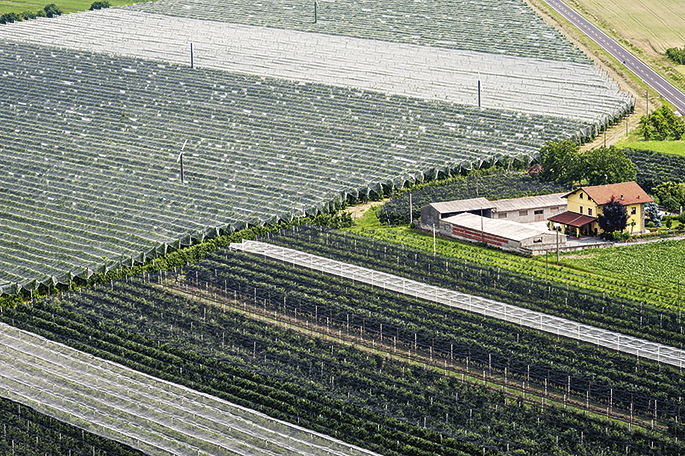Achieving food security is possible, if we better understand the complexity of the agricultural system and re-design practices accordingly.
Early in September, the State of Food Security and Nutrition in the World report was released through a joint press conference at the FAO headquarters in Rome. The analysis (The State of Food Security and Nutrition in the World FAO; 2018) is the outcome of a close collaboration between five United Nations agencies — the Food and Agriculture Organization, the International Fund for Agricultural Development, the United Nations Children’s Fund (UNICEF), the World Food Programme and the World Health Organization — and one of the key messages from the report is, perhaps not surprisingly, alarming: the world is not on track to meet the ‘Zero Hunger’ Sustainable Development Goal, SDG 2.

Alex Ramsay/Alamy Stock Photo
Drawing attention to the drivers of hunger and malnutrition, the report includes updated estimates of a number of indicators related to food security and its health implications, including the number of hungry people in the world, data on child stunting, adult obesity, and childhood obesity among others.
The report, which uses data from 2017, shows how hunger has increased worldwide for the third consecutive year, and childhood malnutrition has not improved or, even worse, in some cases has declined. Countries must take urgent action to meet SDG 2 by 2030.
This year’s edition of the annual report focuses on the need to build climate resilience for food security and nutrition. Acknowledging the dependency of our nutritional needs on the natural environment should indeed be a critical component of any food-policy strategy.
More specifically, the sustainability of the food system should be at the heart of the international food-security debate. Despite increasing hunger globally, the demand of food has been rising rapidly and has had a significant environmental cost: degradation of agricultural land, pollution of rivers and aquifers due to agro-chemicals, increased freshwater consumption, greenhouse-gas emissions from agriculture and land-use change, loss of agro-biodiversity and other negative consequences. All of these environmental impacts severely undermine our ability to continue to feed a growing population and ultimately will jeopardize the opportunity to meet SDG 2, unless more-sustainable food-production practices are embraced globally.
Enhanced agricultural productivity (intensification) has been a major response to the growing food demand, but intensification could be done better. In an Analysis by Pretty et al. published in our August issue, the authors underline how environmental considerations in agriculture intensification have been traditionally limited to minimizing negative impacts. Instead, with their analyses, they show that, for example, a move away from fertilizers to nitrogen-fixing legumes as part of rotations or intercropping could improve intensification without increasing environmental stress. Their point is that agriculture intensification can be sustainable if the system is adequately re-designed and if all players involved accept that no new designed system will succeed forever.
Increasing food production can impact conservation strategies — another issue likely to have long-term negative consequences for our ability to provide healthy levels of nutrition to all. Keesing and colleagues, in an Article in this issue, show however that a conflict between the two shouldn’t be the case. They analyse the potential trade-offs between management for wildlife and for livestock in an East African savannah, and find potential ecological and economic benefits from integrating the two.
However, even while considering effective strategies, it remains clear that human activities do affect biodiversity around the world, and that applies to agricultural practices as much as to other activities. In a Brief Communication in the August issue, Mehrabi et al. analyse the implications of the conservationists’ proposal to give back half the Earth’s surface to nature (the ‘Half-Earth’ project). Among other results, they find that, depending on the landscape conservation strategy, 23–25% of non-food calories and 3–29% of food calories from crops globally could be lost if the proposal were implemented. They do show that the trade-offs between agriculture and the Half-Earth proposal will be much lower if landscapes remain mosaics of shared land uses.
So, what are we left with? We can certainly improve agricultural practices as discussed earlier in this Editorial, and increase their sustainability. Will it be enough to achieve our societal goals? Perhaps we need to also look at our individual behaviour. We know that we need to manage our dependence on nature sustainably. And sustainable management hinges on deep understanding of human–nature relationships. Behavioural sciences can bring invaluable insights to our ways of mapping the complexity of such relationships. Going back to the sustainability of agricultural practices, the different ways in which individuals’ mindsets represent a system and the causal relationships among its components (mental models) can capture more or less complexity, as discussed in an Article by Levy and colleagues in our August issue. The authors show that, for example, mental models characterized by direct, unidirectional causation allow fast decision-making but might fail to anticipate consequences of actions in the presence of strong interdependences. Understanding these cognitive mechanisms has important implications for individual and collective decision-making about sustainable agriculture. And that is crucial to better orient food-security strategies. With the right set of changes in practices and interventions, informed by academic research and practice, there is still hope to achieve SDG 2 on time.
Rights and permissions
About this article
Cite this article
Sustainable agriculture. Nat Sustain 1, 531 (2018). https://doi.org/10.1038/s41893-018-0163-4
Published:
Issue Date:
DOI: https://doi.org/10.1038/s41893-018-0163-4
